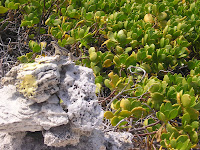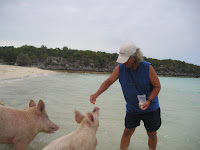Eluethera Island would be our first destination. Founded in 1646 by the Eluetheran Adventurers, who came from England seeking religious freedom, the island is rich in history. It boasts pineapples, quaint villages, friendly people, and, more recently, prosperity. Some descendents of the Adventurers live on the island along with many descendents of loyalists' slaaves.
From Warderwick Wells, we motor sailed through the cut into the Exuma Sound. We turned off the engine, raised all the sails, and sailed northeast in a brisk wind with following (but rolly) seas. Soon our depth finder quit functioning; we were in very deep and cobalt-colored water. We had been cruising the shallow Bank side of the Exuma’s for nearly a month, and we were once again amazed at the purple-blue water of the Sound, so very dark, it can look black, depending on the angle of the sun. Everything is more on the Sound: more wind, higher waves, bigger sea swells and faster speeds. We made excellent time crossing the 29 miles on the Sound; then we were in The Bight, the shallow water on the west, the side we were on, plus the south and north sides of Eleuthera Island. The east side is the Atlantic. The Bight is turquoise but lacks the clarity of the Bank in the Exumas, perhaps because the long island of Eleuthera has only one cut for the ocean water to rush through the area, causing a good flushing and cleaning. The southern end of Eleuthera is shaped like a whale’s tail and our first waypoint in The Bight, Powell Point, is right on the tip of the port side of the whale’s tail. The next ten miles covered three more waypoints, each one requiring a course change that helped keep us off the shifting sand bars and the scattered coral heads. For protection from the south south/west wind, we anchored in the Starved Creek area. We were well protected from the wind for the night.
The next morning, we weighed anchor, motored two miles into Rock Sound, and again dropped the hook. The wind would be clocking and we had good protection from the west, north, and east. The middle of Rock Sound is less than six feet at low mid-tide; we joined the other three sail boats in 7.5 to 8 feet
 of water not far (but far enough) off the rocky east side.
of water not far (but far enough) off the rocky east side.Rock Sound is a good stopover for provisioning; the community businesses welcome boaters and will deliver supplies to the dingy dock. We shopped the well-stocked grocery and liquor stores and filled our empty 20 lb. propane tank (we carry two). In the central part of town, an attractive park area surrounds a natural blue (ocean) hole. Said to be bottomless by the locals, it is really an inland salt water lake, a mile from the ocean, yet it is filled with salt water and sea life and has ocean tides, so some connection (though as yet unknown) exists between this amazing hole and the ocean. Swimming is allowed, but not fishing. Dozens of fish hang around the outside edge waiting for a handout of breadcrumbs.
To see more of this diverse island plus Harbour Island, we rented a car for a road trip. Our query about how long it would take us to reach Harbour Island was met with, “it’s a long way, at least an hour and a half.” Living on an island that is about 60 miles long and narrow, except on both ends, creates a life style that is far different from the life style that most of us are used to. An hour and a half would get us out of Oklahoma City, but would only be half way to Lake Texoma. Of course, a road trip of any length is now a rarity, but traveling an hour and a half in a sailboat is a very short trip.
The drive up the island was fairly slow. The Queen’s Highway on Eleuthera is narrow and curvy with no shoulders or center line, though it does have good signs, especially for the curves. Larry did a great job of driving on the left side, though he and all of us had a few starts when seeing a vehicle coming around a curve driving on the left. It would be on the correct left side, as we were, but it looked completely wrong. None of that stopped us from enjoying our scenic drive, with constant views of either the Bank on one side or the Atlantic on the other, sometimes seeing both easily.
After passing through several villages, we stopped at the Glass Window Bridge that was once a natural arch undermined by the ocean, thus forming a “look through” window. Several years after the natural arc
 h broke through, a narrow manmade bridge was constructed across the rock gorge, once again allowing locals and tourists access between the north and central parts of the island.
h broke through, a narrow manmade bridge was constructed across the rock gorge, once again allowing locals and tourists access between the north and central parts of the island. Every few minutes, an Atlantic roller surges in or a powerful swell hits the rock spine beneath the bridge, foaming and throwing walls of water, ending in a cascading waterfall. Almost yearly, the Glass Window claims at least one victim, carried off the bridge by walls of water 100-120 feet high.
Every few minutes, an Atlantic roller surges in or a powerful swell hits the rock spine beneath the bridge, foaming and throwing walls of water, ending in a cascading waterfall. Almost yearly, the Glass Window claims at least one victim, carried off the bridge by walls of water 100-120 feet high.
We finally dragged ourselves away from the magnificent views and the glimpse of the power of the 3,000 miles of the Atlantic Ocean. Our
 next stop is Harbour Island, known for its gorgeous pink sand beach.
next stop is Harbour Island, known for its gorgeous pink sand beach.




























